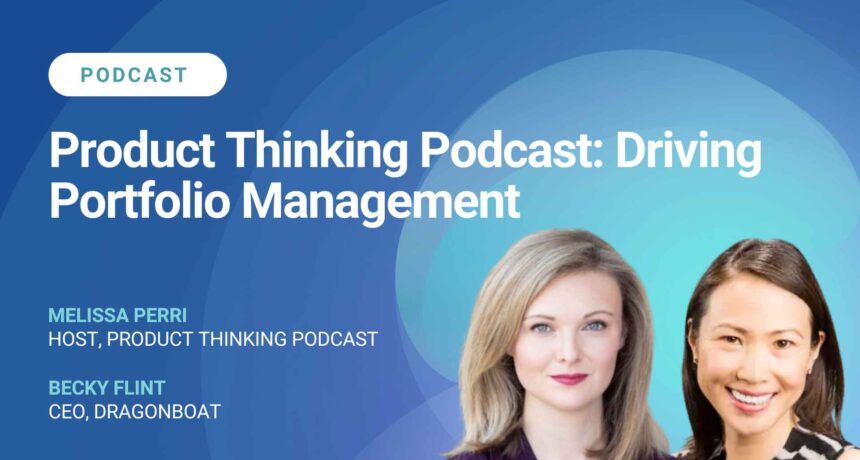Many outcome-driven product leaders are calling portfolio management the latest iteration of agile, but what’s the key to driving portfolio management within your organization?
Find out from the latest episode of Product Thinking with Melissa Perri where Melissa welcomed Dragonboat CEO, Becky Flint. Becky and Melissa discussed the rising need for portfolio management and Becky’s experience building and scaling portfolio management at Paypal, Shutterfly, Feedzai, and BigCommerce.
Here are some highlights from the podcast:
- The growing need for portfolio management tools like Dragonboat
- Why any size team can adopt portfolio management
- Common pitfalls in early portfolio management
- How to drive portfolio management at any organization
The Growing Need for Portfolio Management Tools
Becky never thought she would start a company. She was pushed into it as it became clearer and clearer to her that there was a growing necessity for a product portfolio management tool.
Becky’s eyes were really open to a gap in the market while building the product portfolio management function for fast-growing companies like PayPal, Shutterfly, and Bigcommerce. She tried dozens of PM and PPM tools but none supported the needs of an outcome-focused product organization.
“While I was at PayPal, we were starting our product launch internationally, and alongside it, our product team was scaling from fitting in one conference room to dozens to hundreds. And those growing pains were when we started to realize that the way we ran product wouldn’t sustain us much longer.
We had to learn to run product at a bigger company, for all different types of customers, and in a way that allowed us to adapt to our ever-changing needs. That was what really started the conversation around product process transformation.”
Becky Flint
The traditional way businesses are taught to organize product processes doesn’t work long-term because there are so many facets to a product — e.g market, time horizons, type of investments, etc. Therefore based on Becky’s new-found learnings and her finance background, she proposed portfolio management to the product VP to bring different ways to look at product and create the clarity to make better business decisions.
There was no tool at the time that could fit the needs of outcome focus product portfolio management. As a result, Becky and her team had to build make-shift tools internally. This was the beginning of product portfolio management at PayPal – and about 15 years before it became more well known in the tech industry.
When Becky moved to different companies that is when she realized this need wasn’t unique to PayPal. Thus, portfolio management and portfolio management tools were born.
Why Any Size Team Can Adopt Portfolio Management
Portfolio management is not just for large companies. The biggest lesson Becky took away from her decades working in product is that product today is multifaceted. Even as a product manager of a small team, you need to think of product in different lenses and be able to support every level. That’s where portfolio management comes in.
“Portfolio management is about making decisions across the product organization to support various needs and lenses of the business.
Even for smaller teams, you have to think about what is really helpful for product teams of all sizes to be truly effective in driving the outcomes.”
Becky Flint
Understanding the needs on every level of the organization is the key to creating a successful portfolio that creates solutions for your various customers and shareholders.
Common Pitfalls in Early Portfolio Management
One of the biggest misconceptions around portfolio management is that people tend to think about the portfolio as a hierarchy.
The challenge with hierarchy is that it’s static – once your business changes, you’re stuck. People forget the problem they’re trying to solve when they spend so much time trying to figure out a hierarchy.
This leads to companies making the process too rigid. You don’t need to define every step of the process. Think of a portfolio as a cadence and rhythm that will allow you to look back on.
When companies started out trying to do agile and Scrum purely by the book, they encountered many difficulties. There was just so much learning, evolving and adapting involved in those processes. People finally realized there is the principle and then there is the execution that should follow it. However, it doesn’t have to be exactly the same. This principle is the same with portfolio management.
When driving portfolio management, there’s an even bigger impact than agile because it touches more than just the scrum team. The key to successful portfolio management is being able to iteratively roll out and constantly adapt your process as your business changes. There are problems that are important and there are problems that are urgent. Focus on the problems that are urgent. By doing this, you’ll be able to create a successful portfolio that meets the needs of your company today and into the future.
“You don’t need to roll out portfolios in every facet of your company — that would be way too time-consuming and tedious if you have multiple products. Rather, you can start in a few product areas. Take one or two teams who are ready for change and start to apply portfolio management to areas that are somewhat independent.”
Becky Flint
This “agile roll-out” takes into consideration the areas and opportunities that need to be explored. This also gives you an idea of what portfolio management looks like in one area so you can expand to broader areas with more knowledge.
The last pitfall is not having the right people to drive the internal thought process change. For instance, you needed a change agent and a scrum master to roll out agile. This is the same with becoming outcome-focused, which is why product ops is such a fast-growing and important role.
How to Drive Portfolio Management at Any Organization
There are a few components to properly driving portfolio management. It all comes down to finding the right tool and securing the right roles to drive the right process.
Drive Portfolio Management with Product Operations
Product leadership roles used to require multiple hats, but at a certain point, the team grows and the role becomes too big. That’s why you need product operations driving portfolio management.
Product operations enables effective decision-making. No product can be built by one team, it requires multiple teams. Having product operations partner with product leaders gives you vision, strategy, process, and most importantly data. This allows you to make the best product decisions at all levels.
Product operations allows teams to scale and build upon what they are doing really well and creates new areas to grow. This is essential for teams to not only succeed today but succeed tomorrow.
Chief Product Officers typically hire product operations as their right hand to succeed in driving portfolio management strategy forward. Having a leader focused on the vision and strategy, with product operation focused on the operating framework allows the team to innovate and create new ideas while also iteratively delivering.
Drive Portfolio Management with the Right Tools
Once you realize the problem you have and determine the way you want to work, that’s where a portfolio management tool comes in.
“I got really excited when I met you and I saw Dragonboat because this is something that we manually would try to put together for so many companies for years. We would have analysts spend 40+ hours a week trying to get all the information out of the system, slice and dice it in the right way, and add it to the different pivot tables to do different lenses on it.
But we still had the bigger issues of how do we monitor it after gathering that information? At AthenaHealth, we tried to create a backlog of all the OKRs in Jira to measure the progress that way, but that information wasn’t being tracked systematically. Overall it just didn’t work that well since we had no idea what to use and no products to see our investment in each product across the portfolio, tracking towards OKRs, and the strategy that we had just built and deployed. It was a big struggle to do. That’s what I really love Dragonboat because that’s what you guys are pulling together.“
Melissa Perri
Tools play a big hand in shaping the way you work and creating a process. That’s why the key to successfully driving portfolio management falls on enforcing the process with the right tools and right roles to empower the whole company forward.



